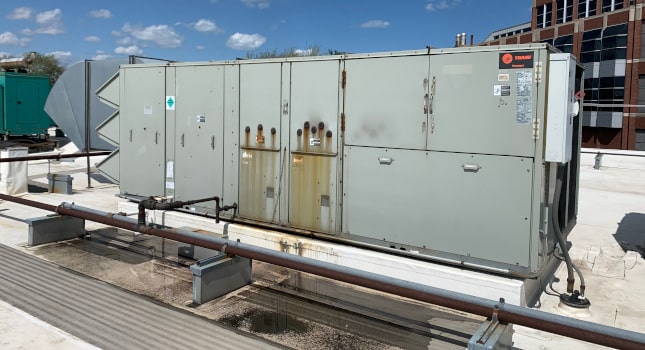Rooftop units (RTUs) play a crucial role in providing air conditioning to specific areas of shops and small commercial buildings. These self-contained HVAC units are compact, simple, and efficient, making them a popular choice. In this article, we will explore the functioning and components of RTU rooftop units, delving into their various types and their capabilities.
Function And Components Of RTU Rooftop Units

RTU rooftop units are essentially air handlers that are specifically designed to be installed on the roof. Unlike conventional air handlers, RTUs are more robust and weatherproof to withstand external elements such as sun, rain, snow, and wind. They are connected to ductwork, which acts as a conduit for distributing conditioned air throughout the building.
Let’s take a closer look at the components commonly found in RTU rooftop units:
- Housing: The housing of an RTU rooftop unit serves as protection for the mechanical and electrical components from external elements. Access panels are incorporated to facilitate maintenance and access to the internal components.
- Air Hood: Located at one end of the unit, the air hood is designed to draw in outside ambient air while preventing water, snow, and debris from entering. Mesh screens are typically installed to keep out wildlife and objects that could obstruct or damage the fan.
- Dampers: Newer models of RTU rooftop units often feature dampers, which are metal sheets that can rotate to control the airflow. These dampers can open or close to regulate the amount of outside air entering the unit. By adjusting their position, the unit can modulate the flow of air, especially when recirculation is involved.
- Filters: Filters are an essential component of RTU rooftop units as they capture dirt and dust present in the incoming fresh air. Regular maintenance and cleaning of filters prevent the accumulation of debris on fans, heat exchangers, mechanical parts, and ductwork, ensuring the unit’s efficiency and longevity.
- Coils: Coils within the RTU rooftop unit are responsible for cooling or heating the air by adding or removing thermal energy. The type and configuration of the coils depend on the unit’s specific heating and cooling capabilities. Some units may have separate coils for cooling and heating, while others utilize a single coil connected to a heat pump for both functions.
- Refrigeration System: Most RTU rooftop units employ a refrigeration system for cooling purposes. Compressors, condensers, fans, and controls are typically located at the rear or side of the unit to dissipate heat away from the intake and conditioned air. This arrangement ensures optimal performance and prevents heat transfer to the interior of the unit.
- Fan: The fan, usually a belt-driven centrifugal or more energy-efficient EC type, pulls outside air through the dampers, filters, and coils. The conditioned air is then pushed into the ductwork for distribution throughout the building, maintaining a comfortable indoor environment.

Different Types Of RTU Rooftop Units
- Fresh Air Only: This basic type of RTU rooftop unit draws in 100% fresh air and does not recirculate the internal air. An external exhaust fan helps balance air pressure by removing the return air.
- Air Recirculation: Some units feature a return ductwork system, allowing for the recirculation of internal air. This feature helps save energy during colder months when mixing warm return air with cold fresh intake air reduces the heating load.
- Airside Economizer: In this design, a portion or all of the air can be rejected to the atmosphere based on factors such as outside air temperature, return air temperature, and CO2 levels. When the outside air temperature aligns with or is close to the desired indoor temperature, the unit can provide 100% fresh air without recirculation, resulting in energy-saving “free cooling” or an airside economizer cycle.
- Heat Wheel Integration: RTU rooftop units equipped with heat wheels are gaining popularity due to the growing emphasis on energy efficiency and reducing CO2 emissions. The heat wheel, a rotating heat exchanger, transfers waste heat or coolth from the return discharge air to the incoming fresh air, offsetting heating and cooling demands. Some units allow for recirculation of return air, further enhancing energy savings.

Conclusion
Rooftop units (RTUs) are integral to the efficient air conditioning of defined areas in shops and small commercial buildings. Understanding their working principles and components helps users make informed decisions about selecting the appropriate RTU rooftop unit for their specific needs. By harnessing the capabilities of RTUs, businesses can create comfortable indoor environments while optimizing energy efficiency and utility costs.






GIPHY App Key not set. Please check settings